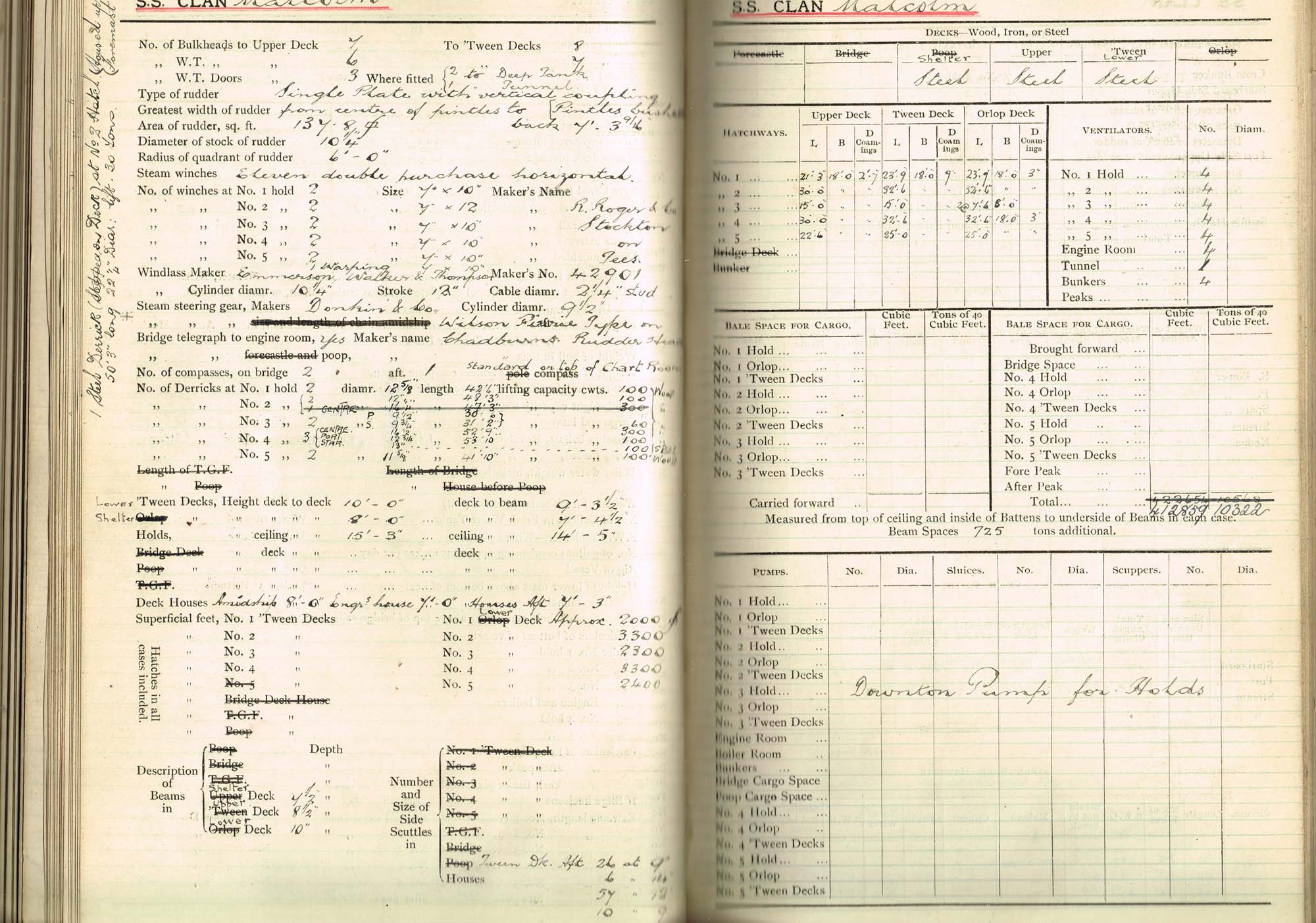
Although Charles Cayzer began business in Liverpool in 1877, calling himself Charles Cayzer & Company, it was in a small way, dealing in ships’ stores. He did manage to acquire an interest in two wooden ships, however, sending them laden to Bombay and making a good profit – a minor portent of things to come. But it was to Glasgow that he soon turned in order to seek finance to help satisfy his ambition to become a successful shipowner for he had realised that there was a growing demand for shipping services from Glasgow and Liverpool to India. With the eventual, but initially reluctant, financial support of John Muir, a wealthy India merchant in Glasgow, the head of James Finlay & Co., he was able to set his plans in motion and, with Alexander Stephen & Sons., shipbuilders of Glasgow, he began negotiations for the construction of his first cargo ships.
Back in Liverpool, he entered into partnership with an old friend, Captain Alexander Irvine and at the beginning of March 1878, in Old Church Yard, Cayzer, Irvine & Co., began to function and to set out on the path that was to end over one hundred years later. It was decided that Irvine would run the Liverpool office whilst Charles Cayzer would base himself in Glasgow. Sadly Alexander Irvine died in 1879 though his name remained forever linked with Charles and the Company.
The Scottish connection
In the autumn of 1878 the first of Charles Cayzer’s ships was launched in Glasgow – the Clan Alpine. He had already decided that this and all his subsequent ships were to bear the prefix ‘Clan’ to reinforce the Scottish connection. Thus began the story of the Clan Line and its management by Cayzer, Irvine & Co. For a couple of years thereafter, although making profits and constructing five more ships, the Company’s debts made its liquidity very uncertain.
In September 1881, Charles Cayzer took the bold decision to set up an entirely new enterprise to be called Clan Line Association Steamers. This was to have no financial connection with the existing six ships, but any new ships acquired by the Association were also to be managed by Cayzer, Irvine & Co. It was in the same year, 1881, that Clan Line began sailings to the Cape Colony in South Africa, a route jealously guarded by the Union Steam Ship Company and Castle Mail Packets Company.
Sailing further afield
With growing confidence and success Charles Cayzer’s next move was to form Clan Line Steamers Ltd., in July 1890, a limited liability company. Charles was chairman with his eldest son, also Charles, reluctantly at his side for the time being, at least. Two of his other sons were later to play leading roles in the company and to take it to new heights after their father’s death: Herbert (from 1899) and August (from 1902). These sons were instrumental in introducing Clan Line sailings to Australia in 1906, much against their father’s better, but erroneous, judgement. As the First World War approached, the Clan Line’s success was such that Charles (knighted 1897, made a baronet in 1904) was tempted to sell the company. He changed his mind in the face of his sons’ strong objections.
The First World War
When war eventually broke out in 1914 the Clan Line fleet numbered 62 ships. During the course of the war Clan Line continued to produce profits and to increase its tonnage, although requisitioning and enemy action made their mark. Twenty-eight ships were lost and 329 crew members.

Sir Charles Cayzer died in 1916 when the war was at its height. His son, August, then became chairman, with his brother Herbert as vice-chairman. In May 1917 they moved the company headquarters from Glasgow to London (St. Mary Axe) and began to acquire other companies: the Scottish Shire Line (1917); British & South American Steam Navigation Company (1918); and the Greenock Dockyard Company (1918). The real potential of the latter was not to be realised until the 1930s.
The post-war years saw widespread stagnation in international shipping. Clan Line survived, however, by concentrating on its core routes to India, South Africa and Australia and by maintaining all its ships at sea. In 1935, as depression lifted, Cayzer, Irvine & Co began to build new ships to the latest designs. By the outbreak of the Second World War in 1939, Clan Line and it associated lines formed one of the largest shipping businesses in the world.
The Second World War
The Second World War was probably more hazardous for the company than the First. Large- scale government requisitioning had a dramatic effect on the running of the business. August (baronet 1921), like his father Sir Charles, died in the midst of war, in 1943. His brother Herbert (baronet 1924, Baron Rotherwick 1939) succeeded him as chairman. By the end of the war thirty-seven ships had been lost and over 600 men.

After 1945 Lord Rotherwick strove to rebuild the Clan Line fleet by initially purchasing and requisitioning existing ships. Increasing competition on its main routes and dock labour disputes from the 1950s onwards caused the company many problems. However in 1955, ably supported by August’s son, Sir Nicholas Cayzer, Lord Rotherwick saw the realisation of a long-held Cayzer family dream. This was the amalgamation, in 1956, with the Union-Castle Line (hostile opinion saw it as a take-over), Clan Line’s old rivals on the South African routes. A new holding company was formed, The British & Commonwealth Shipping Company, with Lord Rotherwick in the chair until his death in 1958, when his place was taken by Sir Nicholas (Baron Cayzer 1981).
Diversification
Although shipping, including the Clan Line, was initially at its heart, the new company began to diversify into such areas as air transport, engineering, hotels, canning and timber. In 1965, Clan Line and its associated lines numbered forty-five ships, all relatively modern vessels, but now began the slow withdrawal from international shipping. In 1978 the first trading loss was made in that business and in 1981 the last of the Clan ships was sold and the Clan Line ceased to exist.
Clan Alpine
From the archive. Agreement and Account of Crew: Clan Alpine 1878. This crew list includes stowaways and indicates the tensions of life at sea.







Note Thomas, James and Henry, the ‘stow aways’. Illiterate crew members would sign their names with an ‘X’ , as seen in this list. 

Note the entry of a crewman who died of hepatitis during this voyage. 
Note the crew man charged with “using threatening and abusive words”. 
Clan Malcolm
From the archive. Below are the particulars of the Clan Malcolm which gives, amongst other things, a considerable amount of detail about her construction, capacity and performance.
Clan imagery
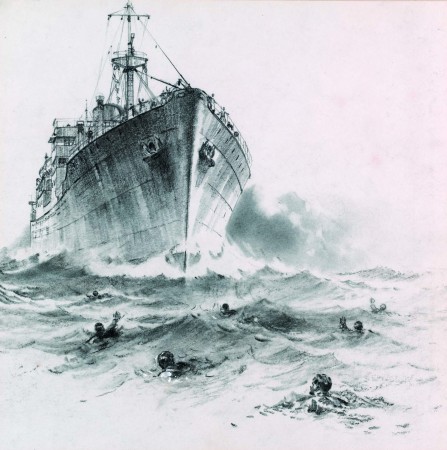
Clan Macbean
Members of a German gun crew are left to their fate after their submarine crash-dives to avoid being rammed by the Clan Macbean whose captain had decided that attack was the best form of defence.
Clan Murray
The Clan Murray narrowly avoiding damage as two North Sea convoys are involved in a near-miss during bad weather.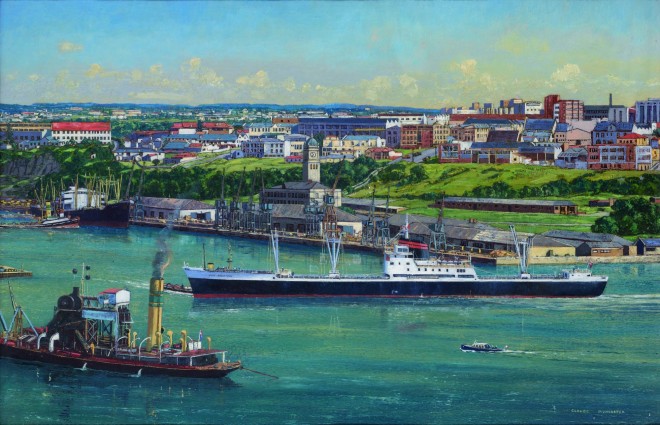
MV Clan Robertson.
The Clan Robertson entered service in 1965, the fourth ship of that name in the Clan Line fleet. She was transferred to the Union-Castle Line in 1976 and re-named Balmoral Castle.
Artist: Claude Muncaster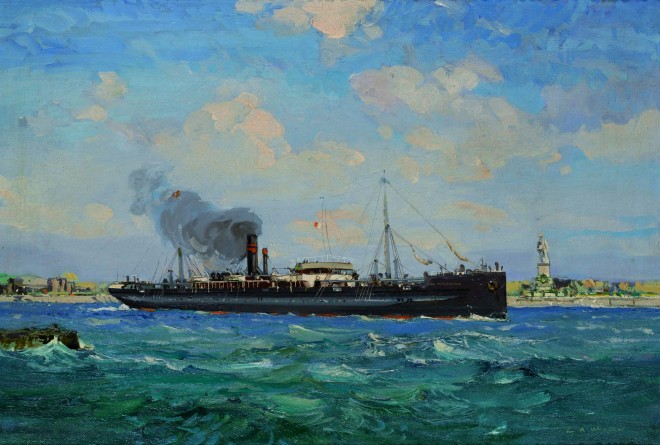
Clan MacDonald, built 1897, passing through the Suez Canal.
This was one of the first ‘turret ships’, a revolutionary new design which could carry more cargo and at lower cost than conventional steamers. Sir Charles Cayzer bought thirty-five turret ships giving the Clan Line a considerable commercial edge over its competitors.
Artist: Lesley Arthur Wilcox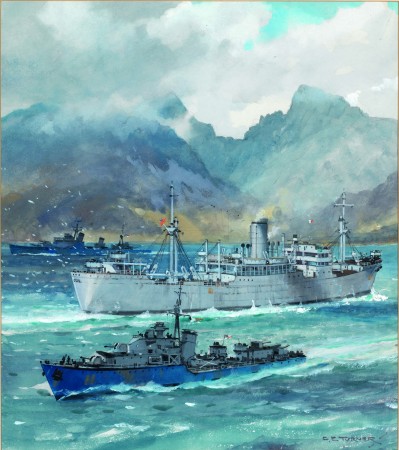
Clan Lamont entering the Clyde during the Second World War.
The Clan Lamont was one of the ships that played a pivotal role in the D-Day landings, 1944.
Artist: C E Taylor

